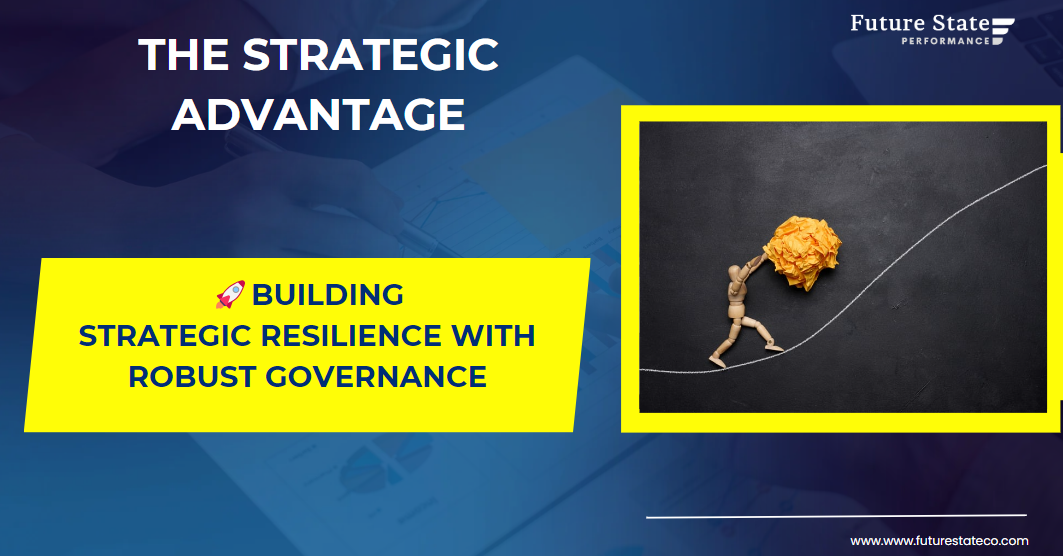Strategy
Building Strategic Resilience with Robust Governance
By Shay Lynch
November 28, 2024
Key Highlights
• Strategic governance is the backbone of successful strategy execution, ensuring clarity, alignment, and adaptability.
• Programme management aligns initiatives, resources, and priorities to prevent chaos and duplication.
• Programmes of work simplify complexity by grouping initiatives, enabling better control and visibility.
• Change management smooths transitions, reducing resistance and fostering employee engagement.
• Iterating the plan allows for flexibility, keeping strategies relevant to changing market dynamics.
• Continuous assessment ensures strategies align with evolving business conditions.
• Metrics and KPIs offer clear insights for tracking progress and driving decisions.
• Risk management anticipates challenges, transforming roadblocks into manageable hurdles.
• Compliance safeguards reputation by meeting legal and ethical standards.
• Situational analysis identifies market shifts, enabling timely adjustments to maintain competitiveness.
Together, these pillars create a robust framework to navigate challenges and seize opportunities, ensuring strategies deliver meaningful results.
Introduction
Embarking on a strategic journey without a robust governance framework is like setting sail without a compass. Governance isn’t just a checkbox; it’s the backbone of successful strategy implementation.
From programme management to risk mitigation, each element plays a crucial role in navigating complexities and achieving long-term success. Let’s dive into the essential pillars of strategic governance:
Programme Management: Aligning Initiatives for Success
Structured programme management ensures resources are optimally allocated and initiatives align with strategic priorities. This prevents duplication, enhances synergy, and keeps execution on track. It is also about spreading the strategy load uniformly throughout the business, so all play their part.
🔹 Consequence of Neglect: Resource misallocation, conflicting efforts, and disorganised implementation.
Programmes of Work: Simplifying Complexity
By grouping related initiatives into projects / chunks of work, organisations gain better control over project interdependencies, resource allocation, and timeline synchronisation. It enhances visibility, reduces complexity, and allows for more effective monitoring and evaluation of progress.
🔹 Consequence of Neglect: Fragmented efforts, lack of synergy, and tracking challenges.
Change Management: Easing Transitions
Addresses employee resistance, nurturing a smooth transition.
Change management is crucial for ensuring that employees understand, accept, and embrace strategic changes. It mitigates resistance, facilitates communication, and supports employees in adapting to new processes, technologies, or roles, nurturing a positive and productive work environment.
🔹 Consequence of Neglect: Resistance, low morale, and failed change implementation.
Iterating the Plan: Staying Agile
Allows flexibility for adjustments based on ongoing insights.
Strategy implementation is a dynamic process, and iterating the plan allows organisations to respond to emerging challenges, capitalise on unforeseen opportunities, and adapt to evolving market conditions. It promotes agility and ensures that the strategy remains relevant and effective.
🔹 Consequence of Neglect: Missed opportunities, rigidity, and irrelevance.
Learning by Doing: Embracing Growth
Encourages a culture of continuous learning and improvement.
Learning by doing fosters a culture where mistakes are viewed as opportunities for growth. It encourages experimentation, innovation, and the development of new skills. Organisations that embrace continuous learning are better positioned to adapt to change and drive long-term success.
🔹 Consequence of Neglect: Stagnation and repeated errors.
Continuous Assessment: Staying Relevant
Regularly evaluates strategy in the context of dynamic business environments.
Continuous assessment ensures that the strategy remains aligned with the ever-changing business landscape. It enables organisations to identify emerging trends, shifts in customer preferences, and changes in the competitive landscape, allowing for timely adjustments to the strategy to maintain competitiveness.
🔹 Consequence of Neglect: Outdated approaches and missed market shifts.
Metrics: Tracking Progress
Establishes quantifiable measures for tracking performance, which should be developed inline with agreed success criteria.
Metrics provide a tangible way to measure progress, identify areas for improvement, and track the success of strategic initiatives. They offer valuable insights for data-driven decision-making, allowing organisations to make informed adjustments and allocate resources effectively.
🔹 Consequence of Neglect: Ambiguity, lack of progress tracking, and uninformed decisions.
Risk Management: Turning Roadblocks into Hurdles
Identifies and addresses potential obstacles to strategy execution.
Proactive risk management minimizes the likelihood of disruptions to strategic initiatives. It involves identifying, assessing, and mitigating risks, ensuring that potential obstacles are anticipated and addressed before they can adversely impact the implementation process.
This is also a crucial mindset shit, instead of seeing things as roadblocks they are hurdles to jump over.
Preparing for risks improves the ability to keep moving forward.
🔹 Consequence of Neglect: Unanticipated setbacks and failure to deliver.
Compliance: Building Trust
Ensures adherence to legal and regulatory requirements.
Compliance is foundational for maintaining organisational integrity. Adhering to legal and regulatory standards not only mitigates legal risks but also protects the organisation’s reputation. It fosters trust among stakeholders and provides a solid foundation for sustainable growth.
🔹 Consequence of Neglect: Legal disputes, financial penalties, and reputational harm.
Situational Analysis: Remaining Proactive
Ongoing assessment of internal and external factors impacting strategy.
Regular situational analysis allows organisations to stay attuned to changes in the business environment. It aids in anticipating potential challenges, identifying new opportunities, and adjusting the strategy accordingly. This proactive approach enhances organisational resilience and responsiveness.
Each element contributes to a robust governance framework, collectively enhancing the likelihood of successful strategy implementation.
🔹 Consequence of Neglect: Strategic misalignment and diminished resilience.
In Conclusion
Strategic governance isn’t just about ticking boxes—it’s the linchpin of success. When each element works together, organisations gain the agility, resilience, and clarity needed to navigate challenges and seize opportunities. In today’s dynamic business world, a strong governance framework is your competitive advantage.
Which of these governance pillars resonates most with your strategic journey? Let’s discuss in the comments! 🚀



